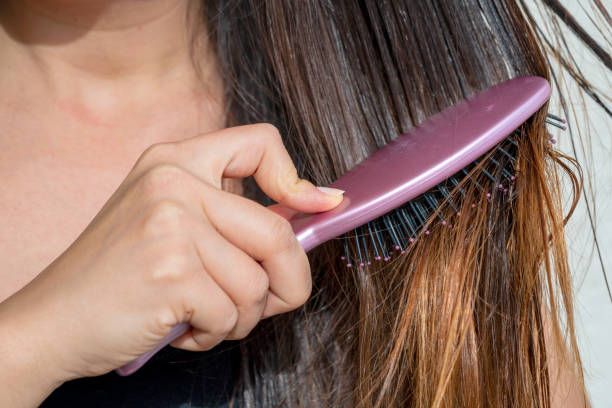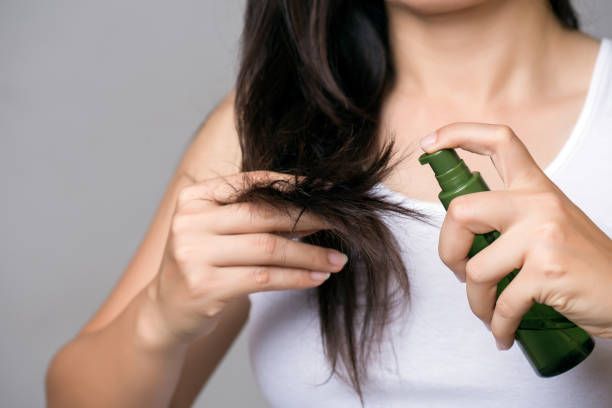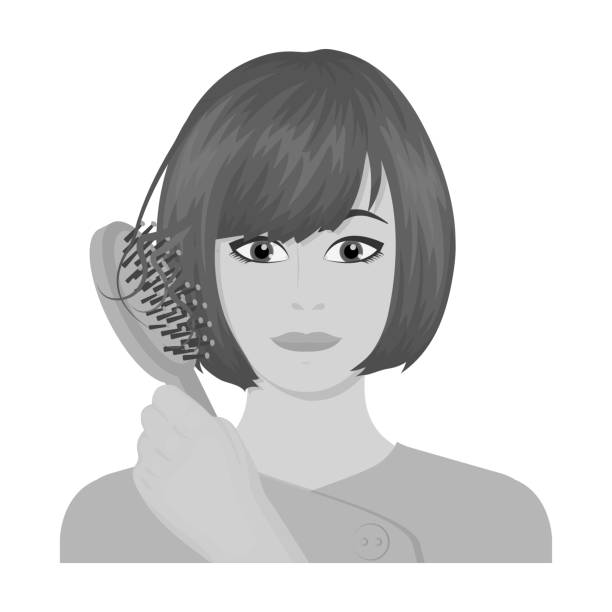Low porosity hair – If you’ve been grappling with hair that seems to defy all your efforts to keep it hydrated and manageable, you might be dealing with the enigmatic phenomenon known as low-porosity hair.
But fret not, because today, we’re diving deep into the world of low porosity hair, exploring what it is, and uncovering the secrets to caring for it.
So, grab your favorite hair products, and let’s embark on this journey to healthier, more vibrant locks!
Cracking the Code: What is Low Porosity Hair?
First, let’s unravel the mystery of low-porosity hair. In the realm of |hair care|, “porosity” refers to your hair’s ability to absorb and retain moisture. As the name suggests, soft porosity hair has a bit of a quirk – it’s not very receptive to water. But what causes this intriguing trait?
The Culprits Behind Low Porosity Hair
Low porosity hair typically arises from two main factors:
1. Tight Cuticle Layer:
The cuticles are the protective outermost layer of your hair shaft. These cuticles are tightly packed in low-porosity hair, like a fortress wall. While this offers excellent protection, It can be challenging for moisture to enter the hair shaft due to this.
2. Product Buildup:
Low-porosity hair tends to accumulate product buildup more easily. The same closed cuticles that keep moisture out can also trap products, leaving your hair feeling weighed down and greasy.
The Telltale Signs of Low Porosity Hair
Now that you know what causes low porosity hair, let’s identify if you’re dealing with it. Here are some common signs:
- Slow Absorption: When you apply water or |hair products|, low-porosity hair takes its sweet time absorbing them. You might notice water beading up on your strands.
- Quick Drying: On the flip side, | low-porosity hair| tends to dry quickly because moisture doesn’t penetrate deeply. This can make it prone to frizz and breakage.
- Product Residue: If you feel like your hair products are just sitting on top of your |hair| rather than being absorbed, that’s a classic sign of |low porosity|.
- Lack of Bounce: Low porosity hair might feel stiff and resistant to styling, lacking that natural bounce and volume.

The Care and Feeding of Low Porosity Hair
Now that you’ve identified low-porosity_hair, it’s time to learn how to care for it. Here are some tips and tricks to make your locks love moisture again:
1. Clarify Regularly: Low-porosity hair can be prone to product buildup. Use a clarifying shampoo occasionally to remove residue and allow moisture to penetrate.
2. Warm Water Rinse: When washing your hair, use warm water. The heat can help open the cuticles slightly, allowing for better product absorption.
3. Pre-Poo Treatment: Consider applying a pre-shampoo treatment with a light oil like coconut or jojoba to help loosen the cuticles before washing.
4. Deep Conditioning: Opt for deep conditioning treatments to provide intense hydration. Use heat or steam to help these products penetrate your hair shaft.
5. Use Lightweight Products: Choose hair products that are lightweight and water-based. Heavy creams and butter can exacerbate buildup.
6. Avoid Overuse of Protein: While protein treatments can be beneficial, overusing them can make low-porosity hair feel stiff and brittle. Use them sparingly.
7. Patience and Consistency: Caring for | low-porosity hair| may require patience. Be consistent with your routine, and give your hair time to adapt.
Low-porosity hair products
Low porosity hair refers to hair strands that have difficulty absorbing moisture due to the tightly closed cuticles. It often leads to products sitting on the hair instead of being drunk, making it challenging to keep it hydrated. To meet the requirements of low-porosity hair, specialized hair care products are designed. Here’s a breakdown of what you need to know about products tailored for low-porosity hair:
1. Clarifying Shampoos:
Low porosity_hair attracts buildup from products. A clarifying shampoo, used occasionally, helps remove residues and opens up the cuticles for better product absorption.
2. Lightweight Moisturizers:
Low porosity hair benefits from lightweight, water-based moisturizers. When shopping for products, checking the ingredients list for items such as aloe vera is advisable. Glycerin and honey can penetrate the hair shaft without weighing it down.
3. Leave-In Conditioners:
They are essential for low-porosity hair, providing continuous moisture without excessive washing. Opt for spray or liquid-based leave-ins that can be easily distributed through the hair.
4. Steam Treatments:
Applying heat through steam can help open the hair cuticles temporarily, allowing products to penetrate better. Consider using a hair steamer or incorporating steam treatments during your deep conditioning sessions.
5. Protein-Free Products:
While protein is crucial for hair health, too much can stiffen and brittle low-porosity hair. Use protein-free or protein-balanced products to maintain the right protein-moisture balance.
6. Avoid Heavy Oils:
Heavy oils such as castor or coconut oil may sit on the hair without absorption. Opt for lighter oils like argan or grapeseed oil, which are more easily absorbed by low-porosity hair.
7. Regular Deep Conditioning:
Deep conditioning treatments with heat (using a shower cap or a hooded dryer) can help open the cuticles temporarily, allowing moisture to penetrate the hair strands effectively.
8. Avoid Product Buildup:
Since low-porosity hair is prone to product buildup, it’s essential to clarify the hair regularly to remove residues. Using apple cider vinegar rinses can help eliminate buildup without stripping the hair.
When selecting products for low-porosity hair, focus on those specifically formulated to provide moisture without weighing the hair down. Understanding your hair’s unique characteristics allows you to choose the right products and establish a tailored hair care routine that keeps your low-porosity locks healthy, hydrated, and vibrant.

Low-porosity hair oils
Low porosity_hair requires specific oils that can penetrate the tightly closed cuticles and provide nourishment without causing buildup. Here’s a guide to selecting the suitable oils for low-porosity hair:
1. Lightweight Oils:
Opt for lightweight oils like argan, grapeseed, and jojoba oil. These oils are easily absorbed, ensuring they don’t sit on the hair surface and weigh it down.
2. Sweet Almond Oil:
Almond oil is excellent for low-porosity hair. It hydrates without leaving a greasy residue.
3. Baobab Oil:
Baobab oil is packed with nutrients and absorbs quickly into the hair shaft. It’s known for improving hair elasticity, making it a suitable choice for low-porosity hair prone to dryness and breakage.
4. Aloe Vera Oil:
Aloe vera oil is light, non-greasy, and deeply moisturizing. It helps balance the hair’s pH levels and provides hydration without causing buildup.
5. Fractionated Coconut Oil:
Fractionated coconut oil remains liquid at room temperature, unlike regular coconut oil. It’s lighter and less likely to cause buildup, making it a good option for low-porosity hair. It still retains the beneficial properties of coconut oil.
6. Argan Oil:
Argan oil is renowned for its ability to hydrate and tame frizz. Antioxidants and essential fatty acids are ideal for low-porosity hair, providing moisture and shine.
7. Avoid Heavy Oils:
Heavy oils like castor or olive oil can be too dense for low-porosity hair and might sit on the surface, causing buildup. It’s best to avoid these oils or use them sparingly.
8. Application Tips:
When applying oils to low-porosity hair, it’s beneficial to use the L.O.C. (Liquid, Oil, Cream) or L.C.O. (Liquid, Cream, Oil) method. Start with a water-based leave-in conditioner, follow with a light, penetrating oil, and finish with a cream-based moisturizer to seal the moisture.
Understanding the specific needs of low-porosity_hair is vital to choosing suitable oils. By selecting lightweight, easily absorbed oils and incorporating them into a proper hair care routine, low-porosity_hair can maintain healthy, well-moisturized locks without fearing product buildup.
Low porosity hair – Conclusion
Low porosity_hair may present challenges, but it has its unique charm. It often boasts a natural shine and resilience. By understanding its needs and tailoring your hair care routine accordingly, you can unlock the true potential of your locks.
So, to all the low porosity beauties out there, remember: your |hair| is unique, and with a bit of T.L.C., it can be just as vibrant and stunning as any other |hair type|.
Embrace your unique locks and journey to healthy, gorgeous hair that truly shines!
FAQs About Low Porosity Hair
Q1: What is low porosity hair, and how is it characterized?
A1: Low porosity_hair refers to hair strands with tightly closed cuticles, making it difficult for moisture or hair products to penetrate. This characteristic often leads to products sitting on the hair rather than absorbed.
Q2: What challenges does low porosity hair face regarding moisture absorption?
A2: Due to the tightly closed cuticles, low-porosity_hair struggles to absorb moisture efficiently. This can lead to dryness, frizz, and a lack of elasticity, making maintaining well-hydrated and manageable hair challenging.
Q3: What are some suitable hair care practices for managing low-porosity hair?
A3: Low porosity_hair benefits from lightweight, water-based products that can penetrate the cuticles. Regular deep conditioning treatments with heat, using the L.O.C. or L.C.O. method, and avoiding heavy oils are essential to ensure proper moisture retention and hair health.
Q4: How can individuals determine if they have low porosity hair, and why is it essential to know one’s hair porosity?
A4: The hair’s porosity can be determined through a simple float test where a strand of hair is placed in water. Understanding one’s hair_porosity is crucial as it helps tailor hair care routines, product choices, and treatments specifically to the hair’s unique needs, ensuring optimal health and manageability.
Read also.. Clove Water for Hair – Benefits and methods of use

